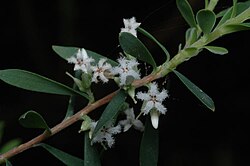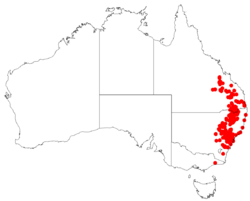Biology:Leucopogon muticus
| Leucopogon muticus | |
|---|---|

| |
| In the Australian National Botanic Gardens | |
| Scientific classification | |
| Kingdom: | Plantae |
| Clade: | Tracheophytes |
| Clade: | Angiosperms |
| Clade: | Eudicots |
| Clade: | Asterids |
| Order: | Ericales |
| Family: | Ericaceae |
| Genus: | Leucopogon |
| Species: | L. muticus
|
| Binomial name | |
| Leucopogon muticus R.Br.[1]
| |

| |
| Occurrence data from AVH | |
Leucopogon muticus, commonly known as blunt beard-heath,[2] is a species of flowering plant in the heath family Ericaceae and is endemic to eastern Australia. It is an erect, straggling shrub with egg-shaped leaves with the narrower end towards the base, and small numbers of white, tube-shaped flowers that are densely bearded inside.
Description
Leucopogon muticus is an erect, straggling shrub that typically grows to a height of up to 1.5 m (4 ft 11 in), and has softly-hairy branchlets. Its leaves are egg-shaped leaves with the narrower end towards the base, 9.6–23 mm (0.38–0.91 in) long and 2.5–5.8 mm (0.098–0.228 in) wide on a petiole 1.5–2.0 mm (0.059–0.079 in) long. The leaves are flat with 3 to 5 parallel veins. The flowers are arranged in spikes of 4 to 10 up to 9 mm (0.35 in) long in leaf axils on a peduncle about 2 mm (0.079 in) long with bracteoles 0.9–1.2 mm (0.035–0.047 in) long at the base. The sepals are 0.9–2.4 mm (0.035–0.094 in) long, the petals joined at the base to form a tube 2.0–2.5 mm (0.079–0.098 in) long with lobes 1.4–2.0 mm (0.055–0.079 in) long and densely bearded inside. Flowering mainly occurs from September to October and the fruit is a bristly, black, elliptic drupe 3.0–4.5 mm (0.12–0.18 in) long.[2][3]
Taxonomy
Leucopogon muticus was first formally described in 1810 by Robert Brown in his Prodromus Florae Novae Hollandiae et Insulae Van Diemen.[4][5] The specific epithet (muticus) means "blunt".[6]
Distribution and habitat
Blunt beard-heath grows in heath and forest on slopes and ridges from sea level to an altitude of 1,000 m (3,300 ft) in south-east Queensland and in eastern New South Wales as far south as Cooma.[2][3]
References
- ↑ "Leucopogon muticus". https://biodiversity.org.au/nsl/services/apc-format/display/111669.
- ↑ 2.0 2.1 2.2 Powell, Jocelyn M.. "Leucopogon muticus". Royal Botanic Garden Sydney. https://plantnet.rbgsyd.nsw.gov.au/cgi-bin/NSWfl.pl?page=nswfl&lvl=sp&name=Leucopogon~muticus.
- ↑ 3.0 3.1 Benson, Doug; McDougall, Lyn (1995). "Ecology of Sydney Plants 3: families Cabombaceae to Eupomatiaceae". Cunninghamia 4 (2): 374. https://www.rbgsyd.nsw.gov.au/getmedia/050a0f06-8c1a-4708-8858-b6d2e40fe5c3/Volume-4(2)-1995-Cun4Ben217-431.pdf.aspx. Retrieved 23 February 2023.
- ↑ "Leucopogon muticus". APNI. https://id.biodiversity.org.au/instance/apni/544341. Retrieved 23 February 2023.
- ↑ Brown, Robert (1810). Prodromus florae Novae Hollandiae et Insulae Van-Diemen, exhibens characteres plantarum. London. p. 543. https://www.biodiversitylibrary.org/item/21871#page/411/mode/1up. Retrieved 23 February 2023.
- ↑ Sharr, Francis Aubi; George, Alex (2019). Western Australian Plant Names and Their Meanings (3rd ed.). Kardinya, WA: Four Gables Press. p. 257. ISBN 9780958034180.
Wikidata ☰ Q17244434 entry
 |

